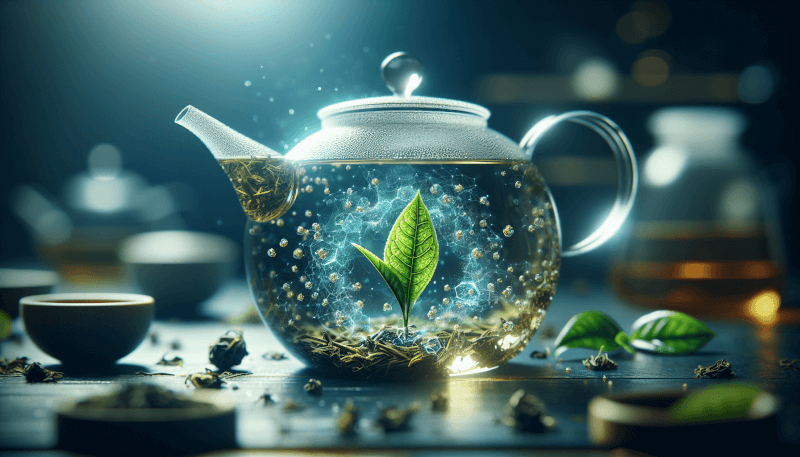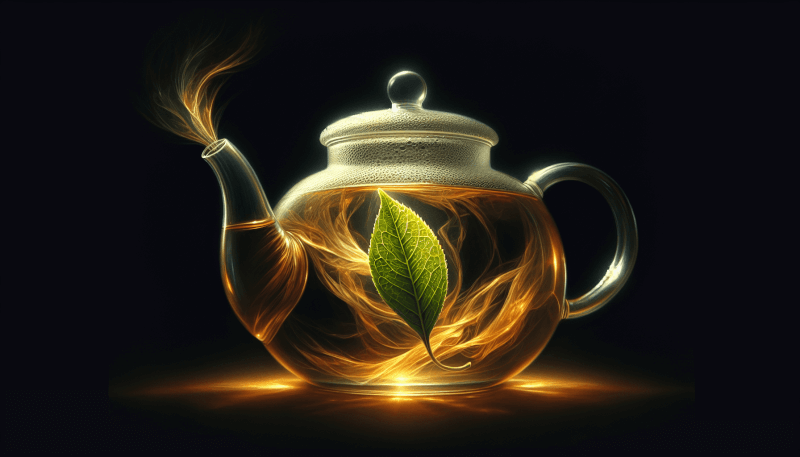Tea lovers, rejoice! Discover the secret to unlocking the full potential of antioxidants in your daily cup of tea. In this article, you will learn how to brew your tea in a way that enhances its antioxidant content, giving you an even more beneficial and rejuvenating experience. Say goodbye to ordinary tea and get ready to elevate your health and wellness to a whole new level with just a few simple steps. Get ready to savor the rich flavors and reap the countless benefits of a truly antioxidant-packed tea.
Understanding Antioxidants
What are antioxidants?
Antioxidants are substances that help protect your cells from damage caused by molecules called free radicals. Free radicals can be harmful to your body because they can damage DNA, proteins, and other important components of your cells. Antioxidants work by neutralizing these free radicals, preventing them from causing damage.
Why are antioxidants important?
Antioxidants play a crucial role in maintaining your overall health and well-being. They help reduce the risk of chronic diseases, such as heart disease and cancer, by protecting your cells from oxidative stress. Oxidative stress occurs when there is an imbalance between free radicals and antioxidants in your body, which can lead to cell damage and inflammation.
Types of antioxidants
There are various types of antioxidants, each with its own unique properties and benefits. Some common antioxidants include vitamin C, vitamin E, beta-carotene, and selenium. These antioxidants can be found in a variety of foods, such as fruits, vegetables, nuts, and seeds.
Tea and Antioxidants
Tea as a source of antioxidants
Tea is one of the most popular beverages in the world and is also a rich source of antioxidants. Both green tea and black tea contain a group of antioxidants called catechins, which are known for their potent health benefits. These catechins, particularly epigallocatechin gallate (EGCG), have been studied for their potential in preventing and treating various diseases.
Types of tea with high antioxidant content
While all types of tea contain antioxidants, there are certain varieties that are known for their high antioxidant content. Green tea is often touted as one of the best sources of antioxidants, thanks to its high catechin content. Matcha, a powdered form of green tea, is also known for its high antioxidant concentration. Other teas, such as black tea and white tea, also contain antioxidants, although in varying amounts.
Benefits of consuming tea antioxidants
Consuming antioxidants from tea can offer a range of health benefits. These antioxidants have been linked to a reduced risk of heart disease, lower blood pressure, improved brain health, and even weight management. Additionally, tea antioxidants may help boost your immune system, reduce inflammation, and promote healthy aging.

Factors Affecting Antioxidant Content in Tea
Tea quality and freshness
The quality and freshness of tea leaves can greatly impact their antioxidant content. High-quality tea leaves that are picked and processed with care tend to retain more antioxidants. It’s important to choose teas from reputable sources to ensure optimal freshness.
Processing methods
The processing methods used to produce different types of tea can also influence their antioxidant content. For example, green tea is minimally processed and undergoes a brief oxidation process, which helps preserve its antioxidant properties. On the other hand, black tea is fully fermented, which may result in some loss of antioxidants during the oxidation process.
Storage conditions
Proper storage conditions are crucial for maintaining the antioxidant content in tea. Exposure to light, air, and moisture can cause the deterioration of antioxidants over time. It is recommended to store tea in airtight containers, away from direct sunlight, at a cool and dry place to preserve its antioxidant properties.
Water temperature and brewing time
The temperature of the water used to brew tea and the duration of the brewing process can affect the extraction of antioxidants. Steeping tea leaves at a higher temperature provides a more efficient extraction of antioxidants, while longer brewing times allow for greater antioxidant release. However, it’s important to find the balance between optimal extraction and ensuring a pleasant taste.
Choosing the Right Tea
Green tea
Green tea is known for its high antioxidant content, particularly catechins like EGCG. It has a fresh and grassy flavor, making it a popular choice for many tea drinkers. Green tea is also available in different varieties, such as Sencha, Matcha, and Gyokuro, each offering its own unique flavor profile and health benefits.
Black tea
Black tea undergoes a full fermentation process, giving it a bold and robust flavor. Although it may contain slightly lower levels of antioxidants compared to green tea, black tea still provides significant health benefits. Popular varieties of black tea include Assam, Darjeeling, and Earl Grey.
White tea
White tea is the least processed among all types of tea, making it rich in antioxidants. It has a delicate and subtle flavor, often described as floral and mellow. White tea is known for its higher levels of polyphenols, a type of antioxidant that may have anti-aging properties.
Oolong tea
Oolong tea is partially fermented, resulting in a flavor profile that falls between that of green tea and black tea. It offers a balance of antioxidants, with studies suggesting that oolong tea may have potential weight management benefits. Oolong tea can have a wide range of flavors, ranging from light and floral to bold and fruity.
Herbal tea
While herbal teas are not derived from the Camellia sinensis plant like other teas, they are often enjoyed for their antioxidant properties. Herbal teas are usually made from a variety of flowers, herbs, and spices, providing a wide range of flavors and health benefits. Some common herbal teas include chamomile, peppermint, and ginger.

Preparing Tea for Maximum Antioxidant Extraction
Selecting high-quality tea leaves
When preparing tea for maximum antioxidant extraction, it’s important to start with high-quality tea leaves. Look for teas that are fresh, properly stored, and sourced from reputable suppliers. High-quality tea leaves contain higher levels of antioxidants, ensuring maximum health benefits.
Proper storage of tea leaves
To maintain the antioxidant content of your tea, it’s crucial to store your tea leaves properly. Keep them in an airtight container away from light, moisture, and strong odors. Avoid storing tea leaves in the refrigerator, as moisture may accumulate and affect their quality.
Optimal water temperature
Different types of tea require different water temperatures for optimal antioxidant extraction. Green tea, for example, is best brewed with water around 175°F (80°C), while black tea can be brewed with water around 200°F (93°C). Oolong tea typically requires water around 195°F (90°C), and white tea is often brewed with water around 180°F (82°C). Adjusting the water temperature ensures that the antioxidants are extracted efficiently without compromising the taste.
Appropriate brewing time
The duration of tea steeping also affects the extraction of antioxidants. As a general guide, green tea should be steeped for about 2-3 minutes, while black tea can be steeped for 3-5 minutes. Oolong tea benefits from a steeping time of around 4-6 minutes, and white tea is typically steeped for 1-3 minutes. Remember that brewing times can vary depending on personal preference and desired strength.
Using loose tea leaves vs. tea bags
Using loose tea leaves rather than tea bags can lead to better antioxidant extraction. Loose tea leaves allow for more surface area exposure, allowing the antioxidants to be released more effectively. Tea bags can sometimes restrict the movement of tea leaves, resulting in less efficient extraction. However, if using tea bags is more convenient, choose high-quality tea bags that provide ample space for the tea leaves to expand.
Brewing Techniques for More Antioxidants
Steeping methods
Apart from water temperature and brewing time, the steeping method can also affect antioxidant extraction. It’s recommended to use a teapot or a tea infuser to allow the tea leaves to move more freely, promoting better extraction. Gently stirring or swirling the tea leaves during steeping can further enhance antioxidant release.
Tips for maximizing antioxidant extraction
To maximize antioxidant extraction, try these tips:
- Use freshly boiled water to ensure the optimal temperature.
- Use the correct amount of tea leaves for the desired strength.
- Cover your teapot or cup while steeping to retain heat and promote extraction.
- Avoid squeezing or pressing the tea leaves after steeping, as this can release bitter compounds.
- If brewing multiple infusions, increase the steeping time slightly with each subsequent infusion.
Special brewing techniques for different types of tea
Certain types of tea require specialized brewing techniques to bring out their full antioxidant potential. For example, matcha, a powdered form of green tea, is traditionally whisked with hot water to create a frothy and creamy beverage. This unique preparation method allows for the ingestion of the entire tea leaf, resulting in a higher antioxidant intake. Similarly, oolong tea enthusiasts may employ the Gongfu Cha method, which involves multiple short infusions using a small teapot to fully explore the tea’s complex flavors and antioxidants.

Enhancing Antioxidant Absorption
Pairing tea with lemon or citrus
Adding lemon or citrus to your tea can enhance the absorption of tea antioxidants. The vitamin C in lemon and other citrus fruits helps stabilize and boost the antioxidant activity of catechins in tea. This combination not only adds a pleasant flavor to your tea but also maximizes the health benefits.
Adding milk to tea
While adding milk to tea is a matter of personal preference, some studies suggest that adding milk may reduce the antioxidant activity of tea. However, the effect seems to vary depending on the type of tea and the milk used. If you prefer to add milk, consider using a lighter dairy alternative or enjoying your tea without any additives to fully benefit from its antioxidants.
Factors that inhibit antioxidant absorption
Certain factors can inhibit the absorption of antioxidants. Consuming tea with a high-fat meal or dairy products may reduce the bioavailability of tea antioxidants. Additionally, medications such as antacids and iron supplements can interfere with antioxidant absorption. It’s best to consume tea on an empty stomach or at least a few hours before or after a meal to maximize antioxidant absorption.
Best Practices for Brewing Tea
Using filtered water
Using filtered water for brewing tea can contribute to a better taste and enhance the antioxidant extraction. Filtered water removes impurities and chlorine that may affect the flavor and overall quality of your tea.
Avoiding over boiling water
Boiling water for too long or vigorously can deplete the oxygen content and alter the taste of your tea. It’s best to remove the water from heat just as it starts to boil, particularly for green and white teas that are more delicate in flavor.
Preheating teaware
Preheating your teapot or teacups can help maintain the optimal temperature during brewing. Pouring a small amount of hot water into the teapot and teacups, swishing it around, and then discarding the water helps warm the vessels and ensures a consistent brewing environment.
Proper tea-to-water ratio
Ensuring the right ratio of tea leaves to water is crucial for a balanced and flavorful brew. Follow the recommended instructions for each type of tea, which usually suggest using 1-2 teaspoons of tea leaves per 8 oz (240 ml) of water. Adjust the amount according to personal preference and desired strength.
Straining or removing tea leaves
To prevent over-steeping and bitterness, it’s important to strain or remove the tea leaves from the water once the desired brewing time has been reached. Leaving the tea leaves in the water for too long can lead to astringent flavors and diminish the overall quality of the brew.

Alternative Brewing Methods
Cold brewing
Cold brewing is a method that involves steeping tea leaves in cold or room temperature water over an extended period, usually overnight. This technique is often used for white and green teas and results in a mild and refreshing iced tea with a lower caffeine content and a smooth flavor profile. Cold brewing can help retain more antioxidants compared to traditional hot brewing methods.
Iced tea
Iced tea is a popular way to enjoy tea, especially during warmer months. It can be prepared by brewing tea at double strength and then pouring it over ice to cool. Adding fresh fruits, herbs, or a splash of citrus can enhance the flavor and add an extra dose of antioxidants.
Matcha preparation
Matcha, a finely ground powdered green tea, requires a special preparation method. Traditionally, matcha is sifted into a bowl, whisked with hot water using a bamboo whisk called a chasen until it forms a frothy beverage. This preparation allows for the consumption of the entire tea leaf, resulting in a concentrated dose of antioxidants.
Infusions with herbs and spices
Infusing tea with herbs and spices is a creative way to add flavor and increase the antioxidant content of your brew. Fresh mint leaves, ginger slices, cinnamon sticks, and even citrus peels can be added to your tea, providing unique flavors and additional beneficial compounds.
Storing and Enjoying Brewed Tea
Storing leftover tea
If you have leftover brewed tea, it’s best to store it in the refrigerator to prevent bacterial growth. Transfer the tea to a clean, airtight container and make sure it is properly sealed. Keep in mind that brewed tea is best consumed within 24 hours to retain its optimal taste and antioxidant properties.
Reheating brewed tea
When reheating brewed tea, avoid using the microwave, as it can cause uneven heating and affect the taste. Instead, gently heat the tea on the stovetop or use a tea warmer to preserve its flavor and antioxidant content. Reheated tea may not have the same freshness as a freshly brewed cup, but it can still provide a satisfying beverage.
Savoring tea at the right temperature
Different types of tea are best enjoyed at specific temperatures to fully experience their flavors and antioxidant profiles. Green tea is typically enjoyed at a lower temperature, around 140°F (60°C), while black tea can be enjoyed at a slightly higher temperature, around 176-185°F (80-85°C). Adjust the temperature based on personal preference and the specific tea variety.
Experimenting with tea flavors
One of the joys of brewing tea is the ability to experiment with different flavors and combinations. From adding fresh fruits and herbs to trying new types of tea, there are endless possibilities to create unique and antioxidant-rich brews. Don’t be afraid to explore and discover your favorite flavors while reaping the benefits of tea antioxidants.
In conclusion, understanding antioxidants and their importance is essential for maintaining good health. Tea, with its rich antioxidant content, offers a delicious and natural way to incorporate antioxidants into your daily routine. By choosing the right tea, using proper brewing techniques, and enhancing absorption, you can ensure maximum antioxidant extraction and enjoy the numerous health benefits that tea antioxidants have to offer. So brew a cup of your favorite tea, savor the flavors, and take in the antioxidant goodness one sip at a time. Cheers to your health!


